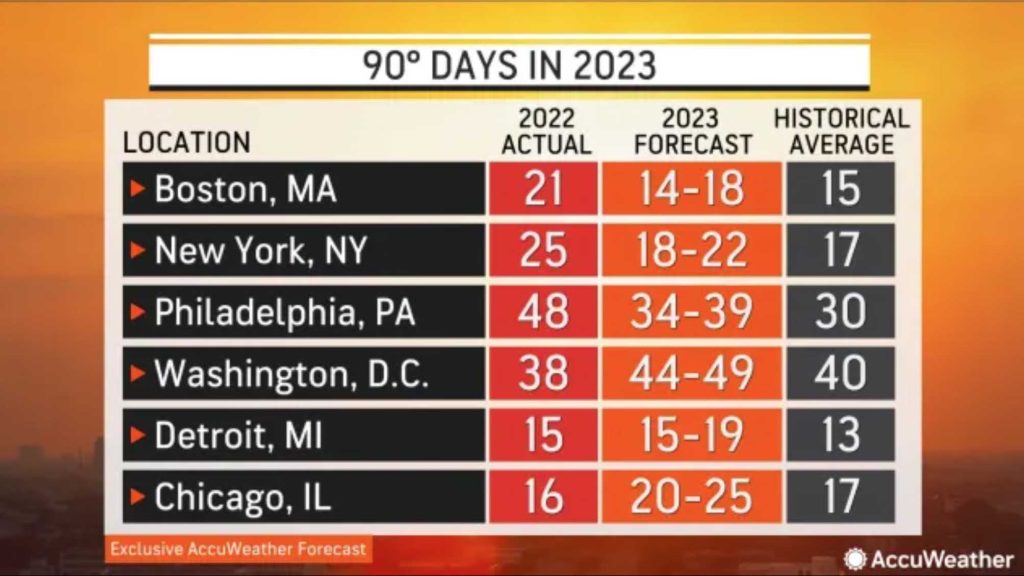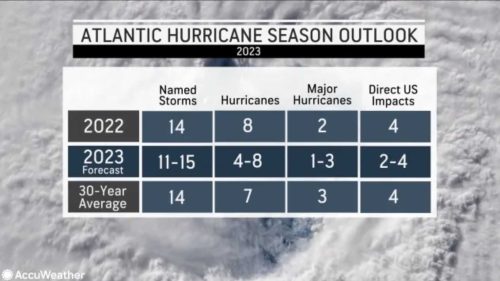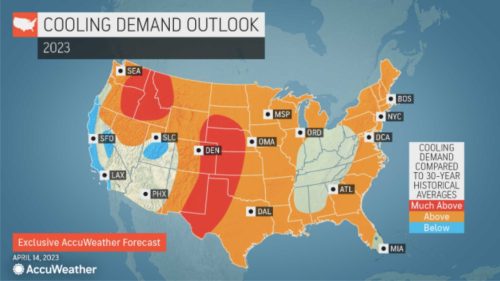Summer 2023
Will it be hot and hazy in South Jersey—or where you’re planning to vacation? When will be the best time to head to the beach? Will lawnmowers get a workout this summer? AccuWeather has the answers to these questions and more.

 Millions of people across the United States have already had a taste of summer weather, and at 10:57 a.m. EDT on Wednesday, June 21, the season will officially get underway.
Millions of people across the United States have already had a taste of summer weather, and at 10:57 a.m. EDT on Wednesday, June 21, the season will officially get underway.
For some, the first taste of summerlike warmth arrived much earlier than normal, including in Washington, DC, where the temperature hit 84 degrees F. on March 23, the same day the capital’s famous cherry blossoms reached peak bloom, which was about two weeks ahead of schedule. However, winter seemingly never wanted to loosen its grip on the northern Plains, including in Minneapolis, following one of the snowiest seasons on record.
While the official start of summer is still a week away, AccuWeather’s team of long-range forecasters, led by Senior Meteorologist Paul Pastelok, has released its annual summer forecast. And the forecasters say the season could get off to a fast start in terms of hot weather for about one-third of the country.
One month, in particular, stands out to AccuWeather meteorologists.
“Our team has concerns about July, which can feature many high-impact events like severe weather, wildfires, significant drought and flooding,” Pastelok said.
Northeast, Midwest face rain, storms before heat swells: A two-sided summer is in the cards for most of the Midwest and Northeast this year, with the weather patterns expected to completely flip part of the way through the season.
Similar to last year, the Midwest and Northeast could experience a wet and stormy start to the summer before drier conditions take over in August. As a result, people may have to mow their lawns on a more frequent basis during the first half of the season compared to the second half.
 August could be the best month to visit the beach, go camping or partake in other outdoor events due to the downturn in rain and storms. However, the month will not be completely dry, so it will still be important to check the free AccuWeather app before spending a day outdoors.
August could be the best month to visit the beach, go camping or partake in other outdoor events due to the downturn in rain and storms. However, the month will not be completely dry, so it will still be important to check the free AccuWeather app before spending a day outdoors.
Energy demand could also rise during the second half of the summer as the heat turns up. A few heat waves will be possible from late July through August from the mid-Atlantic through the Midwest.
The mercury is forecast to reach 90 degrees F. more times in 2023 than in 2022 in several major cities, including Chicago, where the temperature hit the 90-degree mark 16 times in 2022, right around the historical average. AccuWeather meteorologists say there will be about 20 to 25 days of 90-degree heat in the Windy City this year.
New York City, Philadelphia and Boston are not expected to have temperatures in the 90s as frequently in 2023 as in 2022. Still, the number of 90-degree days will likely be near to above the historical average in each city.
The hotter and drier end to summer could cause some pockets of drought to develop in New England and the mid-Atlantic that could linger into the start of autumn.
Early tropical trouble looming for Southeast: The Atlantic hurricane season kicked off on June 1, and it did not take long for a tropical storm/hurricane to spin up in close proximity to the United States.
AccuWeather is predicting a hurricane season close to the 30-year historical average with 11 to 15 named storms, four to eight hurricanes, one to three major hurricanes and two to four systems that will directly impact the U.S.
Outside of the tropical threat, the warm weather in the Gulf and Atlantic will “increase humidity levels and increase the chances of more showers and thunderstorms, especially if we see the pattern in June and July,” Pastelok said.
Severe weather to largely avoid Tornado Alley but could hit big cities: Severe thunderstorm activity has been rampant throughout much of the United States so far this year, producing a record number of tornadoes through the first three months of 2023. Thunderstorms will frequently erupt across a large part of the country this summer, and AccuWeather meteorologists expect more severe weather outbreaks.
There is also a moderate risk of severe weather in the mid-Atlantic this summer, including in New York City, Washington, DC, and Pittsburgh. The risk will be slightly lower in New England, but storms can occasionally rumble over the region.
Damaging winds, hail and isolated tornadoes will be possible with the most vigorous storms, but any thunderstorm can spark lightning.
Lightning kills about 20 people in the U.S. every year, and between 2006 and 2019, more than 70 percent of lightning-related deaths occurred in June, July or August. Anyone who is outdoors and hears thunder should seek shelter and remain indoors until the storm has passed, forecasters say.
Delayed arrival of summer warmth for western U.S.: Sustained hot spells may slowly take hold over the western U.S. this year following a winter with historic snowfall and excessive rainfall. The lingering moisture in the ground, paired with the cool water off the immediate coast, will lead to a delayed start to summery weather in some of the region’s biggest cities, such as Los Angeles, San Francisco and San Diego.
Low clouds and fog will be more frequent along the coast of California during the early part of the summer, limiting how high temperatures will rise. However, this will only delay the inevitable. “You’re still gonna have your dry spots in California and parts of Nevada and Arizona that are going to heat up at times,” Pastelok added. “No doubt about that.”
The interior Northwest and northern Rockies will have brief warmups early in the summer, but the heat will really turn up during the second half of July. As a result, the cooling demand is predicted to be much higher across the Northwest than in California, southern Nevada, Utah and Arizona, compared to historical averages.
Not only will the arrival of long stretches of summer weather be delayed across the West, but so will the arrival of the annual monsoon season. A monsoon is a large-scale change in the wind that can promote rain and thunderstorms over a region of the world spanning weeks or months.
In 2021 and 2022, the North American monsoon began around mid-June, but this year, AccuWeather meteorologists say that it may not kick into gear until July.
The monsoon will deliver some rain to the interior West, but the more significant concern will be the lightning associated with the storms. Lightning strikes can ignite wildfires that could burn for months. Storms may also disrupt outdoor plans and create flash flooding in and around some popular national parks across the western U.S.
Lightning from thunderstorms associated with the monsoon can spark fires across the West, serving as a natural ignition source for blazes during the upcoming wildfire season.
The return of El Niño and what it means for the summer forecast: After three years when La Niña had a heavy hand in the storm track across North America, its reign has finally come to an end and is predicted to be swiftly replaced by its counterpart, El Niño. AccuWeather meteorologists say El Niño will develop in short order, but there are still some uncertainties weighing on the minds of forecasters.
El Niño is a regular climate pattern that occurs when the water near the equator of the eastern Pacific Ocean is warmer than historical averages. The warmer water can alter the jet stream in the Northern Hemisphere and the overall weather patterns thousands of miles away from the Pacific Ocean.
How quickly El Niño develops and how strong it becomes will determine how exactly it will affect the weather in the U.S. this summer. Regardless of its strength, Pastelok said it would have more of an impact on the tropics than anywhere else. This is one reason why AccuWeather is not forecasting an above-normal Atlantic hurricane season.
El Niño will continue to reshape the weather patterns over North America through the remainder of 2023 and into the start of 2024.









